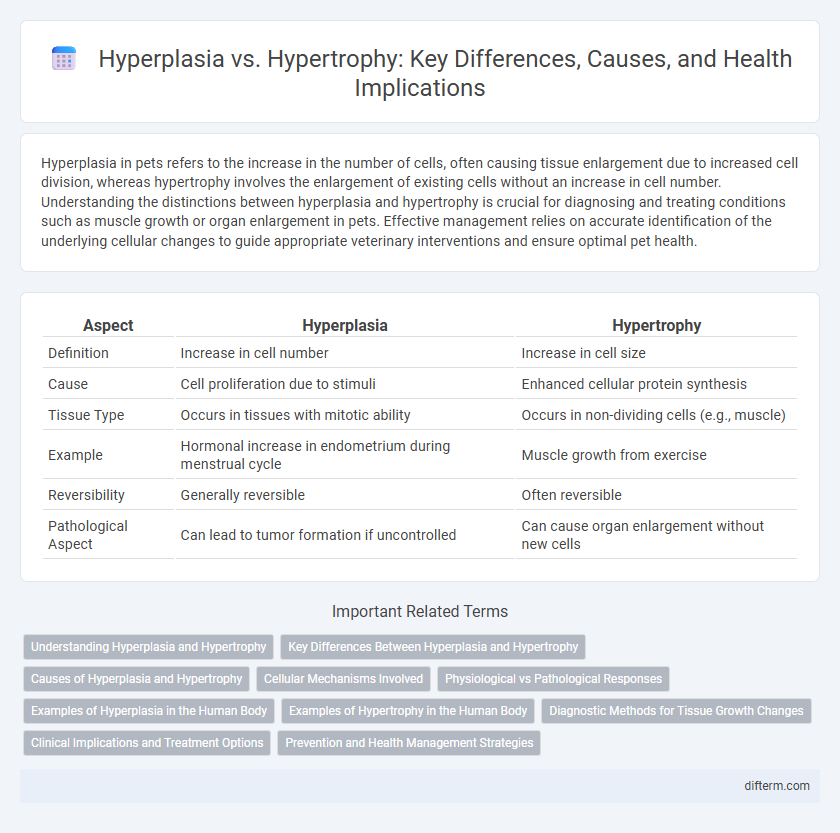Hyperplasia in pets refers to the increase in the number of cells, often causing tissue enlargement due to increased cell division, whereas hypertrophy involves the enlargement of existing cells without an increase in cell number. Understanding the distinctions between hyperplasia and hypertrophy is crucial for diagnosing and treating conditions such as muscle growth or organ enlargement in pets. Effective management relies on accurate identification of the underlying cellular changes to guide appropriate veterinary interventions and ensure optimal pet health.
Table of Comparison
| Aspect | Hyperplasia | Hypertrophy |
|---|---|---|
| Definition | Increase in cell number | Increase in cell size |
| Cause | Cell proliferation due to stimuli | Enhanced cellular protein synthesis |
| Tissue Type | Occurs in tissues with mitotic ability | Occurs in non-dividing cells (e.g., muscle) |
| Example | Hormonal increase in endometrium during menstrual cycle | Muscle growth from exercise |
| Reversibility | Generally reversible | Often reversible |
| Pathological Aspect | Can lead to tumor formation if uncontrolled | Can cause organ enlargement without new cells |
Understanding Hyperplasia and Hypertrophy
Hyperplasia refers to an increase in the number of cells within a tissue or organ, leading to its enlargement, commonly seen in hormonal tissues like the prostate or endometrium. Hypertrophy, on the other hand, involves the enlargement of existing cells, such as muscle fibers responding to strength training or cardiac muscle in hypertension. Distinguishing between hyperplasia and hypertrophy is crucial for diagnosing conditions and guiding treatment strategies in pathological and physiological organ growth.
Key Differences Between Hyperplasia and Hypertrophy
Hyperplasia involves an increase in the number of cells in a tissue or organ, whereas hypertrophy refers to the enlargement of existing cells without cell division. Hyperplasia commonly occurs in tissues capable of mitosis, such as the liver or skin, while hypertrophy is typical in muscle cells where cell replication is limited. Understanding the distinction is crucial for diagnosing pathological conditions like benign prostatic hyperplasia or muscle growth response to exercise.
Causes of Hyperplasia and Hypertrophy
Hyperplasia occurs due to increased cell proliferation often triggered by hormonal stimulation or chronic irritation, such as in the endometrium during the menstrual cycle or in the prostate gland due to androgens. Hypertrophy results from an increase in the size of existing cells primarily caused by mechanical stress or increased functional demand, commonly seen in skeletal muscle after exercise or in the myocardium due to hypertension. Both processes contribute to organ enlargement but involve distinct cellular mechanisms driven by different physiological and pathological stimuli.
Cellular Mechanisms Involved
Hyperplasia involves an increase in the number of cells through active cell division controlled by growth factors and signaling pathways such as the mitogen-activated protein kinase (MAPK) cascade. Hypertrophy results from the enlargement of existing cells due to increased protein synthesis regulated by pathways like the mechanistic target of rapamycin (mTOR) and enhanced gene expression. Both processes adapt tissues to physiological or pathological stimuli but differ fundamentally in cellular response mechanisms.
Physiological vs Pathological Responses
Hyperplasia involves an increase in cell number, often seen as a physiological response during tissue growth or repair, such as in the female uterine lining during the menstrual cycle. Hypertrophy refers to an enlargement of existing cells, typically occurring in muscle tissues like the heart or skeletal muscles in response to increased workload, representing both physiological adaptations and pathological conditions when excessive. Pathological hyperplasia can lead to abnormal tissue growth linked to diseases like benign prostatic hyperplasia, while pathological hypertrophy often contributes to organ dysfunction, exemplified by hypertrophic cardiomyopathy.
Examples of Hyperplasia in the Human Body
Hyperplasia in the human body commonly occurs in tissues such as the endometrium during the menstrual cycle, where increased cellular proliferation prepares the uterus for potential pregnancy. Another example is benign prostatic hyperplasia, characterized by an enlarged prostate due to increased epithelial and stromal cell numbers, which often affects older men. Additionally, bone marrow hyperplasia results in enhanced production of blood cells during conditions like anemia or infection, reflecting the body's adaptive response to increased physiological demand.
Examples of Hypertrophy in the Human Body
Skeletal muscle hypertrophy occurs with resistance training, leading to increased muscle fiber size and strength. Cardiac hypertrophy develops in response to high blood pressure or valvular heart disease, causing enlargement of the heart muscle. Adipose tissue hypertrophy results from excess calorie intake, where fat cells enlarge without increasing in number.
Diagnostic Methods for Tissue Growth Changes
Diagnostic methods for hyperplasia and hypertrophy primarily include histopathological examination and imaging techniques. Hyperplasia is identified by an increased number of cells through biopsy and microscopic analysis, while hypertrophy is characterized by enlarged cell size often visualized via MRI or ultrasound imaging. Molecular assays and immunohistochemistry further aid in differentiating cellular activity and tissue structure alterations in these growth changes.
Clinical Implications and Treatment Options
Hyperplasia involves an increase in cell number, often seen in conditions like benign prostatic hyperplasia, whereas hypertrophy is characterized by an enlargement of existing cells, commonly observed in cardiac or muscle tissues. Clinically, hyperplasia may require treatments targeting abnormal cell proliferation, such as hormone therapy or surgical intervention, while hypertrophy management focuses on addressing underlying stressors like hypertension using medications such as ACE inhibitors or lifestyle modifications. Understanding the distinct cellular mechanisms aids in selecting appropriate therapeutic strategies and predicting patient outcomes.
Prevention and Health Management Strategies
Preventing hyperplasia and hypertrophy involves maintaining a balanced diet rich in antioxidants and anti-inflammatory foods to reduce cellular stress and abnormal tissue growth. Regular exercise and weight management are crucial for controlling hormone levels and metabolic factors that contribute to tissue enlargement. Monitoring underlying health conditions and following medical advice for early intervention can significantly improve outcomes in managing both hyperplasia and hypertrophy.
Hyperplasia vs Hypertrophy Infographic

 difterm.com
difterm.com